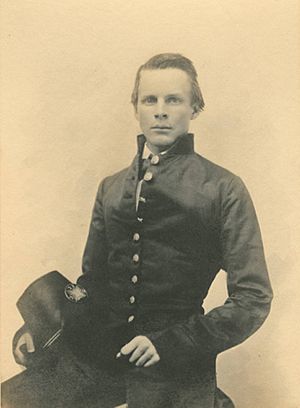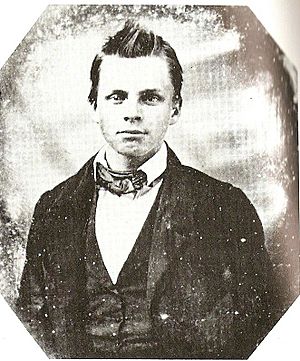John Pelham (officer) facts for kids
Quick facts for kids
John Pelham
|
|
|---|---|

John Pelham in his West Point uniform in 1858
|
|
| Born | September 7, 1838 Near Alexandria, Alabama |
| Died | March 17, 1863 (aged 24) Culpeper, Virginia |
| Place of burial |
City Cemetery in Jacksonville, Alabama
|
| Allegiance | |
| Service/ |
|
| Years of service | 1861–1863 |
| Rank | |
| Battles/wars | American Civil War |
John Pelham (born September 7, 1838 – died March 17, 1863) was a brave artillery officer. He fought for the Confederate army during the American Civil War. He was known as "The Gallant Pelham" because he used his cannons in new and clever ways. He made his artillery move quickly with the cavalry, which caused a lot of trouble for the Union soldiers.
Contents
Early Life and Education
John Pelham was the third of seven children. He was born near Alexandria, Alabama, on his grandparents' farm. His parents were Dr. Atkinson and Martha Pelham.
He grew up on his family's large farm, which was about 1,000 acres. From a young age, he learned how to raise horses.
In 1856, a local Congressman helped Pelham get into the United States Military Academy in New York. This school is often called West Point.
Joining the Civil War
By 1860, there was talk of Southern states leaving the United States. Pelham worried he might not be able to finish his studies at West Point.
In 1861, as war began, Pelham wrote to Jefferson Davis, the new leader of the Confederacy. He asked if he should leave West Point. Pelham decided to resign from West Point just weeks before he was supposed to graduate.
He joined the army of his home state, Alabama. Soon after, he went to Virginia and became a lieutenant in the artillery.
Pelham's Horse Artillery
Pelham's artillery unit was very well-trained. This caught the attention of General J.E.B. Stuart. Stuart gave horses to Pelham's men. This changed Pelham's unit into "horse artillery." This meant his cannons could move much faster than regular artillery.
Pelham fought in over 60 battles with Stuart's cavalry. These included major fights like the First Battle of Bull Run and the Battle of Kelly's Ford. He was the main artillery leader for Stuart at the Battle of Antietam and the Battle of Fredericksburg.
Key Battles
At the Battle of Antietam (also called Sharpsburg), Pelham's cannons were on a hill. From there, he fired at the Union lines. His shots caused many problems for the Union soldiers.
At the Battle of Fredericksburg, Pelham's cannons were far ahead of the main Confederate lines. He held back a large part of the Union army for several hours. This gave the Confederates time to prepare and stop the Union attacks. General Robert E. Lee praised Pelham for his "unflinching courage" during this battle. Pelham was only using two cannons at the time, but he used them very effectively.
Pelham's Death
On March 17, 1863, Pelham was at the Battle of Kelly's Ford. He was taking part in a cavalry charge, and his cannons were not being used. During the fight, a piece of an exploding Union shell hit him in the head.
He was taken about six miles away to Culpeper Courthouse. Sadly, he died the next morning without waking up.
Pelham's Legacy
After his death, the Confederate Senate promoted Pelham to lieutenant colonel. This was a special honor. His body was brought home and buried in City Cemetery in Jacksonville, Alabama. A statue was put up in downtown Jacksonville in 1909 to remember him.
In 1894, a poet named James R. Randall wrote a poem called John Pelham.
In 1901, a painting of Pelham was hung with other Confederate officers in Alexandria, Virginia. General Joseph Wheeler gave a speech, calling him "the Gallant Pelham."
The cities of Pelham, Alabama and Pelham, North Carolina, are named after him. In 2004, a part of State Highway 300 in Georgia was named the John Pelham Memorial Parkway.
The United States Field Artillery also named army camps after him, such as Camp Pelham in Korea.
In the 1970s, a lake in Culpeper, Virginia, was named Lake Pelham to honor him.
John Pelham's 1858 photograph was very famous among white Southerners after the Civil War. The original photo was thought to be lost for a long time. It was kept safe by his sister's family. In 2010, it was sold at an auction.
In March 2013, Jacksonville, Alabama, celebrated Pelham's life. They had a weekend of historical events and recreated his funeral procession.
Pelham was known as one of the most effective Confederate leaders against the Union troops.




